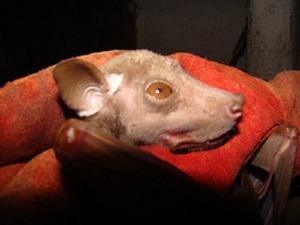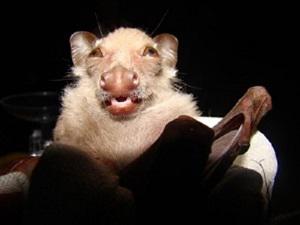Eric Moise Bakwo Fils
Other projects
15 Mar 2010
The Role of the Fruit Bat Eidolon Helvum in Seed Dispersal of Azadirachta indica, a Valuable Multipurpose Tree in the Sahelian Region of Northern Cameroon
The overall aims of this project are to study and evaluate the role of fruit bats as keystone species in plant-animal interaction in the southern Cameroon rainforest.
The knowledge of central African bats remains a field where few studies have been carried out up to now. Therefore, scientific information on these species and theirs distribution in this region is lacking, although this is essential for the development of strategies for the conservation of these animals.

Epomops buettikoferi.
Despite the functional significance of bats in maintaining the balance of nature, they rarely receive the research or conservation attention garnered by more visible and popular wildlife species such as primate or elephant, and as such, bats rank among the most persecuted and threatened animals worldwide and they are not even considered in long term plan for sustainable use of tropical forests.

Epomops franqueti.
The best way to change the current status of bats from persecuted to protected in Cameroon, a country whose struggling economy heavily on natural resource extraction, would be firstly, to clearly demonstrate the ecological and economical important role of these animals and secondly, to help those who manage forests and those that rely on them for their live hood better understand the mutual interdependence between forest plants and bats.
The project goal is to inventory bats species in the Dja reserve and understand their role in fundamental ecological process such as seed dispersal.
Methods:
1-Inventory and distribution
Each of the four site will be sampled monthly for bats species and theirs numbers. Each sampling event consisted of 6 consecutive capture night (18h-24h) using four mist nets per habitat type .Each captured bats will be identify, measured weight and sexed;
2-Faecal collection (bat’s diet)
Each bats netted will be placed in a clean cloth bag for up to two hours to obtain faecal sampled and then released. Each faecal sample will be stored in an individual waxed paper envelope and each seed found in faeces of each species will be counted and identified by a plant taxonomist;
3-Germination trials
Germination trials will be realize with seeds from ripe fruits, ejecta pellets spat out by bats and faeces. We will recorded the germination time of each treatment;
4-Diurnal and nocturnal observations
3 days per month, diurnal and nocturnal observations will be made on feeding roosts and day roosts sites where we will place plastics sheets to collect rejected pellets and faeces .We will realize a GPS mapping of all the day roosts in the study site.